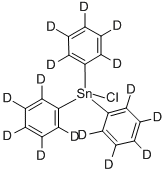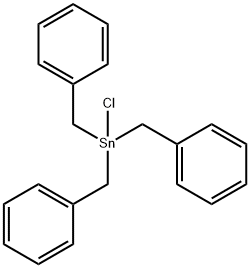TRIMETHYLTIN CHLORIDE
Synonym(s):Chlorotrimethylstannane
- CAS NO.:1066-45-1
- Empirical Formula: C3H9ClSn
- Molecular Weight: 199.27
- MDL number: MFCD00000520
- EINECS: 213-917-8
- SAFETY DATA SHEET (SDS)
- Update Date: 2025-09-28 17:38:58

What is TRIMETHYLTIN CHLORIDE?
Chemical properties
WHITE CRYSTALS
The Uses of TRIMETHYLTIN CHLORIDE
Trimethyltin chloride is an organotin reagent widely used in transferring trimethylstannyl groups onto the substrates to synthesize various organostannanes. Trimethylstannyl compounds derived from this reagent, are extensively used in the palladium-catalyzed Stille coupling reactions.
What are the applications of Application
Trimethyltin chloride is an organometallic compound for proteomics research
General Description
Solid.
Reactivity Profile
TRIMETHYLTIN CHLORIDE is in the family of tin compounds widely used as stabilizers for plastics, additives to paint(as antifouling agents). Some have catalytic properties. Examples include butyl tin, dibutyl tin oxide. Their main hazard is associated with their high toxicity, in skin adsorption or inhalation.
Hazard
A deadly poison. A reproductive hazard.
Health Hazard
(Non-Specific -- Tin Compounds, Organic) The material is an irritant to the skin and gastrointestinal tract. Contact may specifically damage the following target organs: central nervous system, eyes, liver, urinary tract, and skin.
Health Hazard
Trimethyltin chloride and other organotin compounds are highly toxic by ingestion,
inhalation, or skin contact. Trimethyltin chloride can cause irritation and burns of the
skin and eyes. Organotin compounds can affect the central nervous system. The
degree of toxicity is greatest for compounds with three or four alkyl groups attached
to tin. Diand monoalkyltin compounds are moderately toxic. The toxicity diminishes
as the size of the alkyl groups increases. Thus, the oral LD50s in rats are as follows:
dimethyltin dichloride, 74 to 237 mg/kg; tributyltin chloride, 122 to 349 mg/kg;
dibutyltin oxide, 487 to 520 mg/kg; trioctyltin chloride, >4000 mg/kg.
Organotin compounds have been shown to cause reproductive effects in laboratory
animals.
Fire Hazard
When heated to decomposition, TRIMETHYLTIN CHLORIDE emits toxic fumes of chlorides. Avoid decomposing heat.
Fire Hazard
Not a significant fire hazard. Emits toxic fumes in fire.
Flammability and Explosibility
Not a significant fire hazard. Emits toxic fumes in fire.
Safety Profile
A deadly poison by intravenous route. Experimental reproductive effects. See also TIN COMPOUNDS. When heated to decomposition it emits toxic fumes of Cl-.
Incompatibilities
Trimethyltin chloride and other organotin halides react with water to produce hydrogen halides. Organotin hydrides react with water to produce hydrogen gas, which is flammable and explosive.
Waste Disposal
Excess trimethyltin chloride or other organotin compound and waste material containing this substance should be placed in an appropriate container, clearly labeled, and handled according to your institution's waste disposal guidelines.
Properties of TRIMETHYLTIN CHLORIDE
| Melting point: | 37-39 °C (lit.) |
| Boiling point: | 148 °C |
| Density | 0.988 g/mL at 25 °C |
| Flash point: | 207 °F |
| storage temp. | Poison room |
| solubility | Chloroform (Slightly) |
| form | Liquid |
| color | White |
| Specific Gravity | 1.356 |
| Odor | Strong unpleasant stench; no threshold data available |
| Water Solubility | Soluble in water, chloroform and organic solvents. |
| Sensitive | Moisture Sensitive |
| Hydrolytic Sensitivity | 4: no reaction with water under neutral conditions |
| BRN | 3535111 |
| Exposure limits | ACGIH: TWA 0.1 mg/m3; STEL 0.2 mg/m3 (Skin) NIOSH: IDLH 25 mg/m3; TWA 0.1 mg/m3 |
| Stability: | Moisture Sensitive |
| CAS DataBase Reference | 1066-45-1(CAS DataBase Reference) |
| EPA Substance Registry System | Trimethyltin chloride (1066-45-1) |
Safety information for TRIMETHYLTIN CHLORIDE
| Signal word | Danger |
| Pictogram(s) |
 Skull and Crossbones Acute Toxicity GHS06  Environment GHS09 |
| GHS Hazard Statements |
H410:Hazardous to the aquatic environment, long-term hazard |
| Precautionary Statement Codes |
P262:Do not get in eyes, on skin, or on clothing. P273:Avoid release to the environment. P280:Wear protective gloves/protective clothing/eye protection/face protection. |
Computed Descriptors for TRIMETHYLTIN CHLORIDE
| InChIKey | KWTSZCJMWHGPOS-UHFFFAOYSA-M |
New Products
4,4-Difluoropiperidine hydrochloride tert-butyl 9-methoxy-3-azaspiro[5.5]undecane-3-carboxylate Indole Methyl Resin N-Isopropylurea N,N-Dicyclohexylcarbodiimide(DCC) MELDRUMS ACID 5-METHYLISOXAZOLE-4-CARBOXYLIC ACID Magnessium Bis glycinate Zinc ascorbate 1-bromo-2-butyne 2-acetamidophenol 9(10H)-anthracenone Erythrosin B, 4-Piperidinopiperidine 2-((4-morpholinophenylamino) (methylthio) methylene) malononitrile 2,4-dihydroxybenzaldehyde 3-(4-morpholinophenylamino)-5-amino-1H-pyrazole-4-carbonitrile Methyl 2-methylquinoline-6-carboxylate 2,6-dichloro-4-nitropyridine 4-Bromo-2-chlorobenzonitrile 2-(benzylamino)acetic acid hydrochloride 4-(tert-Butoxycarbonylamino)but- 2-ynoic acid 3,4-dihydro-2H-benzo[b][1,4]dioxepine 1-Phenyl-1-cycloprppanecarboxylicacidRelated products of tetrahydrofuran








You may like
-
 Trimethyltin Chloride CAS 1066-45-1View Details
Trimethyltin Chloride CAS 1066-45-1View Details
1066-45-1 -
 Trimethyltin chloride CAS 1066-45-1View Details
Trimethyltin chloride CAS 1066-45-1View Details
1066-45-1 -
 Trimethyltin chloride solution CAS 1066-45-1View Details
Trimethyltin chloride solution CAS 1066-45-1View Details
1066-45-1 -
 Trimethyltin chloride solution CAS 1066-45-1View Details
Trimethyltin chloride solution CAS 1066-45-1View Details
1066-45-1 -
 3-(4-amino-1-oxoisoindolin-2-yl)-1-methylpiperidine-2,6-dione 98%View Details
3-(4-amino-1-oxoisoindolin-2-yl)-1-methylpiperidine-2,6-dione 98%View Details -
 20677-73-0 (2,2-diethoxyethyl)methylamine 98%View Details
20677-73-0 (2,2-diethoxyethyl)methylamine 98%View Details
20677-73-0 -
 3-(4-(hydroxyamino)-1-oxoisoindolin-2-yl)piperidine-2,6-dione 98%View Details
3-(4-(hydroxyamino)-1-oxoisoindolin-2-yl)piperidine-2,6-dione 98%View Details -
 57381-49-4 2-bromo-4-chlorobenzonitrile 98%View Details
57381-49-4 2-bromo-4-chlorobenzonitrile 98%View Details
57381-49-4
